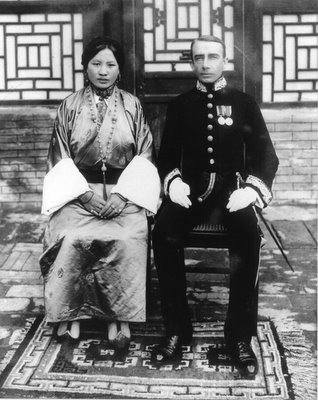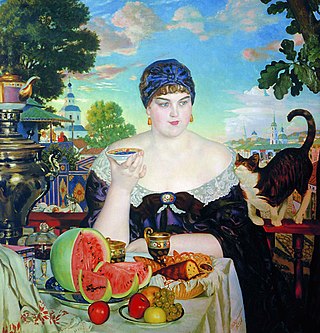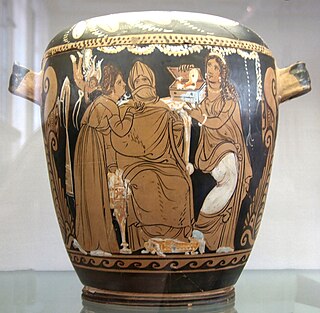Jointure was a legal concept used largely in late mediaeval and early modern Britain, denoting the estate given to a married couple by the husband's family. One of its most important functions was providing a livelihood for the wife if she became widowed, and it is most often used in this sense, interchangeably with dower.
After marriage, the father of the husband would settle lands or income [1] on the couple to enable them to lead an economically independent life. This usually took the form of a settlement by deed, giving the couple joint tenancy for the duration of their lives (ensuring that the wife would keep all of the property upon being widowed). [1] The eldest son and his wife, who would inherit the whole family estate on his father's death, received their jointure for the father's lifetime, while younger sons retained their jointure lands after their father died. The lands thus given to younger sons were either inherited by their descendants or reabsorbed into the family estate. Jointures were often given 'in survivorship', meaning that the wife would retain it if she survived the husband. [2] In this case, the couple's jointure would form part or whole of the wife's promised dower. [3] It is in this sense that the word is most often used. [2]
Customarily, the jointure the head of a family allotted to his son and daughter-in-law in survivorship was proportionate to the dowry the wife brought into the marriage. The amount the couple received reflected the relative social status and economic power of the families of bride and groom. For example, if a wealthy commoner married a woman from a poorer noble family, she would be given a larger jointure in compensation for the elevated status she brought to her husband's family. [2]
After marriage, a wife could bar her right to dower by a fine being levied. This meant that in practice, jointures could also be created by a post-nuptial settlement, provided the wife was willing. Wives (or their relatives on their behalf) often paid their husband a lump sum (known as a portion) or otherwise handed over her property to him, in exchange for a jointure (usually being more than a third) being settled on her for life. This might (in practice) be in the form of a share of the whole property or the right to a particular part of it or an annuity from it. In practical terms, over the course of the 18th century it became fairly common for a widow's portion of an estate to be based on a fixed percentage of the money she brought to the marriage, with an annuity of ten percent being normative. Thus, if a wife came to a marriage with a settlement of £5,000, she would be entitled to an income of £500 per annum for life or until she remarried. A legal contract for jointure was generally seen as more advantageous to the groom's family as otherwise the wife might be entitled to claim the income from up to a third of her husband's estate should he predecease her. Jointure agreements however carried their own risks, such as in the event of a long widowhood. Women who outlived their husbands by many years, sometimes decades, could put the estate under financial strain with the legal obligation to pay the annual annuity. Remarriage generally ended a jointure as the wife became the financial responsibility of her new husband and his family. [4]
The 1536 Statue of Uses introduced the concept of legal jointures into English law. The requirements for legal jointure were (1) that it 'must take effect immediately' when the husband died, (2) that it must be for the wife's lifetime or be terminable by her, (3) that it must be made before marriage takes place (if it was made after, the wife could choose to void it after being widowed), and (4) that it must represent the entirety of the dower owed to the widow. If the bride accepted any provision instead of a dower before marriage, she could not lay claim to one later; if she accepted a similar provision after marriage, she could chose between receiving a jointure or a dower (even if she had explicitly stated that she accepted the provision in place of a dower).
Following the introduction of legal jointures, jointures settled by a deed of joint tenancy were known as equitable jointures in law. [1]

Marriage, also called matrimony or wedlock, is a culturally and often legally recognized union between people called spouses. It establishes rights and obligations between them, as well as between them and their children, and between them and their in-laws. It is nearly a cultural universal, but the definition of marriage varies between cultures and religions, and over time. Marriage becomes a social construct to adjudicate the conflicts of interest between consenting individuals and a transactional means to fulfill their needs. Typically, it is an institution in which interpersonal relationships, usually sexual, are acknowledged or sanctioned. In some cultures, marriage is recommended or considered to be compulsory before pursuing sexual activity. A marriage ceremony is called a wedding, while a private marriage is sometimes called an elopement.

Babylonian law is a subset of cuneiform law that has received particular study due to the large amount of archaeological material that has been found for it. So-called "contracts" exist in the thousands, including a great variety of deeds, conveyances, bonds, receipts, accounts, and most important of all, actual legal decisions given by the judges in the law courts. Historical inscriptions, royal charters and rescripts, dispatches, private letters and the general literature afford welcome supplementary information. Even grammatical and lexicographical texts contain many extracts or short sentences bearing on law and custom. The so-called "Sumerian Family Laws" are preserved in this way.

A wife is a woman in a marital relationship. A woman who has separated from her partner continues to be a wife until their marriage is legally dissolved with a divorce judgment. On the death of her partner, a wife is referred to as a widow. The rights and obligations of a wife to her partner and her status in the community and law vary between cultures and have varied over time.
A dowry is a payment, such as property or money, paid by the bride's family to the groom or his family at the time of marriage. Dowry contrasts with the related concepts of bride price and dower. While bride price or bride service is a payment by the groom, or his family, to the bride, or her family, dowry is the wealth transferred from the bride, or her family, to the groom, or his family. Similarly, dower is the property settled on the bride herself, by the groom at the time of marriage, and which remains under her ownership and control.
In Islam, a mahr is the obligation, in the form of money, possessions or teaching of verses from the Quran by the groom, to the bride at the time of the Islamic Wedding. While the mahr is often money, it can also be anything agreed upon by the bride such as jewelry, home goods, furniture, a dwelling or some land. Mahr is typically specified in the marriage contract signed upon marriage.

The legal rights of women refers to the social and human rights of women. One of the first women's rights declarations was the Declaration of Sentiments. The dependent position of women in early law is proved by the evidence of most ancient systems.

A ketubah is a Jewish marriage contract. It is considered an integral part of a traditional Jewish marriage, and outlines the rights and responsibilities of the groom, in relation to the bride. In modern practice, the ketubah has no agreed monetary value, and is seldom enforced by civil courts, except in Israel.
In property law, a concurrent estate or co-tenancy is any of various ways in which property is owned by more than one person at a time. If more than one person owns the same property, they are commonly referred to as co-owners. Legal terminology for co-owners of real estate is either co-tenants or joint tenants, with the latter phrase signifying a right of survivorship. Most common law jurisdictions recognize tenancies in common and joint tenancies.

Dower is a provision accorded traditionally by a husband or his family, to a wife for her support should she become widowed. It was settled on the bride by agreement at the time of the wedding, or as provided by law.
Courtesy tenure is the legal term denoting the life interest which a widower may claim in the lands of his deceased wife, under certain conditions. The tenure relates only to those lands of which his wife was in her lifetime actually seised and not therefore to an estate of inheritance.

A husband is a man involved in a marital relationship, commonly referred to as a spouse. The specific rights, responsibilities, and societal status attributed to a husband can vary significantly across different cultures and historical periods, reflecting a global perspective on this role.

Daniel Parke Custis was an American planter and politician who was the first husband of Martha Dandridge. After his death, his widow, Martha Dandridge Custis married George Washington, who later became the first president of the United States.
Casato is the principle of kinship practiced in early modern Europe. Casato focuses on the vertical lineage passed on from fathers to sons. It is also known as the agnatic perspective. This is different from the opposing term parentado which stresses kinship formation that included the role of women and men. Both casato and parentado coexisted in early modern Italy.
Loretta de Braose, Countess of Leicester was one of at least five daughters and four sons who survived to adulthood of William de Braose, lord of Bramber in Sussex and Radnor, Abergavenny and Brecon in Wales and his wife, Maud de St. Valery.

The Custom of Paris was one of France's regional custumals of civil law. It was the law of the land in Paris and the surrounding region in the 16th–18th centuries and was applied to French overseas colonies, including New France. First written in 1507 and revised in 1580 and 1605, the Custom of Paris was a compilation and systematization of Renaissance-era customary law. Divided into 16 sections, it contained 362 articles concerning family and inheritance, property, and debt recovery. It was the main source of law in New France from the earliest settlement, but other provincial customs were sometimes invoked in the early period.
Dudley v Dudley (1705) Prec Ch 241; 24 ER 118 is a 1705 case of the Court of Chancery commonly cited in textbooks on law for its statement on the nature of equity.
The dowry system in India refers to the durable goods, cash, and real or movable property that the bride's family gives to the groom, his parents and his relatives as a condition of the marriage. Dowry is called "दहेज" in Hindi and as جہیز in Urdu.

Bride price, bride-dowry, bride-wealth, bride service or bride token, is money, property, or other form of wealth paid by a groom or his family to the woman or the family of the woman he will be married to or is just about to marry. Bride dowry is equivalent to dowry paid to the groom in some cultures, or used by the bride to help establish the new household, and dower, which is property settled on the bride herself by the groom at the time of marriage. Some cultures may practice both simultaneously. Many cultures practiced bride dowry prior to existing records.
Courtship and marriage in Tudor England (1485–1603) marked the legal rite of passage for individuals as it was considered the transition from youth to adulthood. It was an affair that often involved not only the man and woman in courtship but their parents and families as well. While the lower class had more freedom to chose their spouse, the middle and higher classes often ways to build upon a family's wealth, to elevate a family's position within society, or to secure an alliance between families.

Marriage in ancient Greece had less of a basis in personal relationships and more in social responsibility, however it is important to note; the available historical records on the subject focus exclusively on Athens or Sparta and primarily on the aristocratic class. According to these records, the goal and focus of all marriages was intended to be reproduction, making marriage an issue of public interest. Marriages were usually arranged by the parents; on occasion professional matchmakers were used. Each city was politically independent and each had its own laws concerning marriage. For the marriage to be legal, the woman's father or guardian gave permission to a suitable man who could afford to marry. Daughters were usually married to uncles or cousins. Wintertime marriages were popular due to the significance of that time to Hera, the goddess of marriage. The couple participated in a ceremony which included rituals such as veil removal, but it was the couple living together that made the marriage legal. Marriage was understood to be the official transition from childhood into adulthood for women.